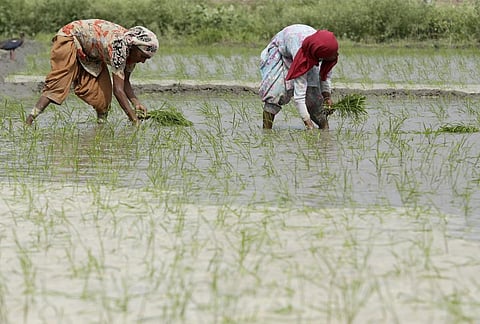

Unexpected heavy rainfall in October has ended the hopes of paddy farmers in northeastern Bihar’s Seemanchal and Kosi regions of getting a good crop this year.
Vinod Kumar, a scientist at the Araria Krishi Vigyan Kendra, told this reporter that heavy rains October 18 and 19, 2021 had damaged harvested paddy and also affected standing paddy.
“No one expected this. The rains have not only damaged paddy but will also delay cultivation of rabi crops such as potato due to waterlogging and moisture in fields,” Kumar said.
Satyendra Jha and Ravindar Yadav, who are marginal farmers of Araria district, were happy till last week as they expected a good paddy harvest either by the end of October or early next month.
But their hopes have been dashed after the heavy rains of the last 48 hours.
“Several farmers had harvested paddy and left it to dry in their fields. They would be hit hard. The rains have also damaged flowering paddy,” Yadav, a resident of a village under the Sikti block, said.
“The standing paddy is now submerged under rainwater and is unlikely to germinate as rains continue October 20. This will affect paddy output per hectare and quality as well,” Jha, a resident of a village near Forbesganj, said.
Pravin Kr Jha, Kishanganj district agriculture officer, said he has directed all block-level agriculture officials to survey and assess damage caused to paddy by heavy rains and submit a report soon.
“The magnitude of the damage will be known only after block agriculture officials submit their reports,” he added.
The state agriculture department had released the state’s official paddy production target of 118 lakh metric tonnes (MT) in August this year. The target last year was 90 lakh MT last year.
This year, paddy has been transplanted in nearly 72 per cent of the total 33 lakh hectares identified for production, as compared to 29.22 lakh hectares last year.
But last week, Sanjay Kumar, additional chief secretary in the state Cabinet, said repeated floods and surplus rains had damaged standing crops across thousands of hectares as farmland.
Standing crops were damaged in about 663,776.28 hectares due to floods, excessive rains and waterlogging this year, according to the agriculture department’s assessment.
Farmers could not even sow in about 141,227 hectares this kharif season as large tracts of agricultural land remained under water due to excessive monsoon rainfall.
The state government for the first time earmarked Rs 100 crore in farm subsidy to farmers who could not cultivate on their land due to waterlogging.
Strange monsoon
This year, Bihar has received only three per cent surplus rainfall after the arrival of the monsoon on time. This is less than last year when the state received 25 per cent surplus rainfall from June to September.
Heavy rainfall in the state is normal during July and August. But Bihar received surplus rainfall in June this year, just as the monsoon arrived. This resulted in floods in the low-lying areas.
Sanjay Kumar, weather scientist at the India Meteorological Department, Patna, said Bihar recorded surplus rainfall in June 2020 and 2021.
“This is the maximum rainfall the state has received in the last decade in June,” he said.
According to him, Bihar received 97.8 millimetres (mm) of rain in June 2019, nearly 40 per cent less than normal; 100.3 mm in 2018; 84.6 mm in 2017; 128.7 mm in 2016 and 123.6 mm in 2015.
After the monsoon had retreated from the region, Bihar has received 140.3 mm rainfall October 18-19, 2021, according to the India Meteorological Department. This was 157 per cent more the 54.7 mm the state usually receives at this time.
The rainfall was especially heavy in the Seemanchal and Kosi regions of the state.
Araria received 95 mm rainfall between October 18 and 19. Other places that received heavy showers included Kishanganj (67.45 mm), Katihar (66 mm), Khagaria (74.9 mm), Saharsa (74 mm), Supaul (50 mm) and Madhepura (45 mm).
The local meteorological office has forecast more rainfall in the coming two to three days.
Heavy rain in Bihar during October was unusual, according to weather experts. They did not rule out climate change as the cause.